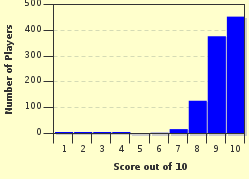Quiz Answer Key and Fun Facts
1. In Spanish: La Nariz; in Italian: Il Naso; in Portuguese: O Nariz. A feature sometimes quite prominent like the one belonging to a famous puppet, which grew every time he lied. What is the name of this facial body part in English?
2. In Catalan: Els Llavis; In French: Les Lèvres; In Spanish: Los Labios. Sometimes described as full or luscious, this paired body part is undoubtedly Angelina Jolie's trademark. What is the name of this facial body part in English?
3. In Italian: Il Collo; in Galician: O Pescozo; in Romanian: Gâtul. A favorite spot for the mythical vampires to bite their victims. What is this articulated body part called in English?
4. In Romanian: Genunchiul; in Galician: A Xeonllo; in Spanish: La Rodilla. Known to be the most complicated joint in the human body, what is this body part called in English?
5. In French: Les Yeux; In Catalan: Les Ulls; In Portuguese: Os Olhos. With its various ranges of color, they are supposed to be the place where beauty is beheld. What is this pair of sensory body parts called in English?
6. In Romanian: Degetul; In Provençal: Lo Det; In Spanish: El Dedo. In part, they allow your grip and are commonly used to point at things, what is this body part called in English?
7. In Catalan: La Galta; In Neapolitan: 'o Mascariéllo; In Italian: La Guancia. Often prone to blushing, and commonly either kissed or slapped, what is the name of this facial body part in English?
8. In Sicilian it is "la iamma/l'amma"; in Provençal, "la camba"; in Portuguese "a perna". Containing the longest bone in the human body, what is the name of this limbic body part in English?
9. In Galician: O Cóbado; In Romanian: Cotul; In Neapolitan: 'o Gùveto. Allowing the bending of your arm, what is the name of this articulation in English?
10. In Neapolitan: 'a Recchia; In French: L'Oreille; In Spanish: La Oreja. A very common place to have piercings, a famous boxer had part of it bitten off during a match. What is the name of this body part in English?
Source: Author
Ludax
This quiz was reviewed by FunTrivia editor
Bruyere before going online.
Any errors found in FunTrivia content are routinely corrected through our feedback system.

